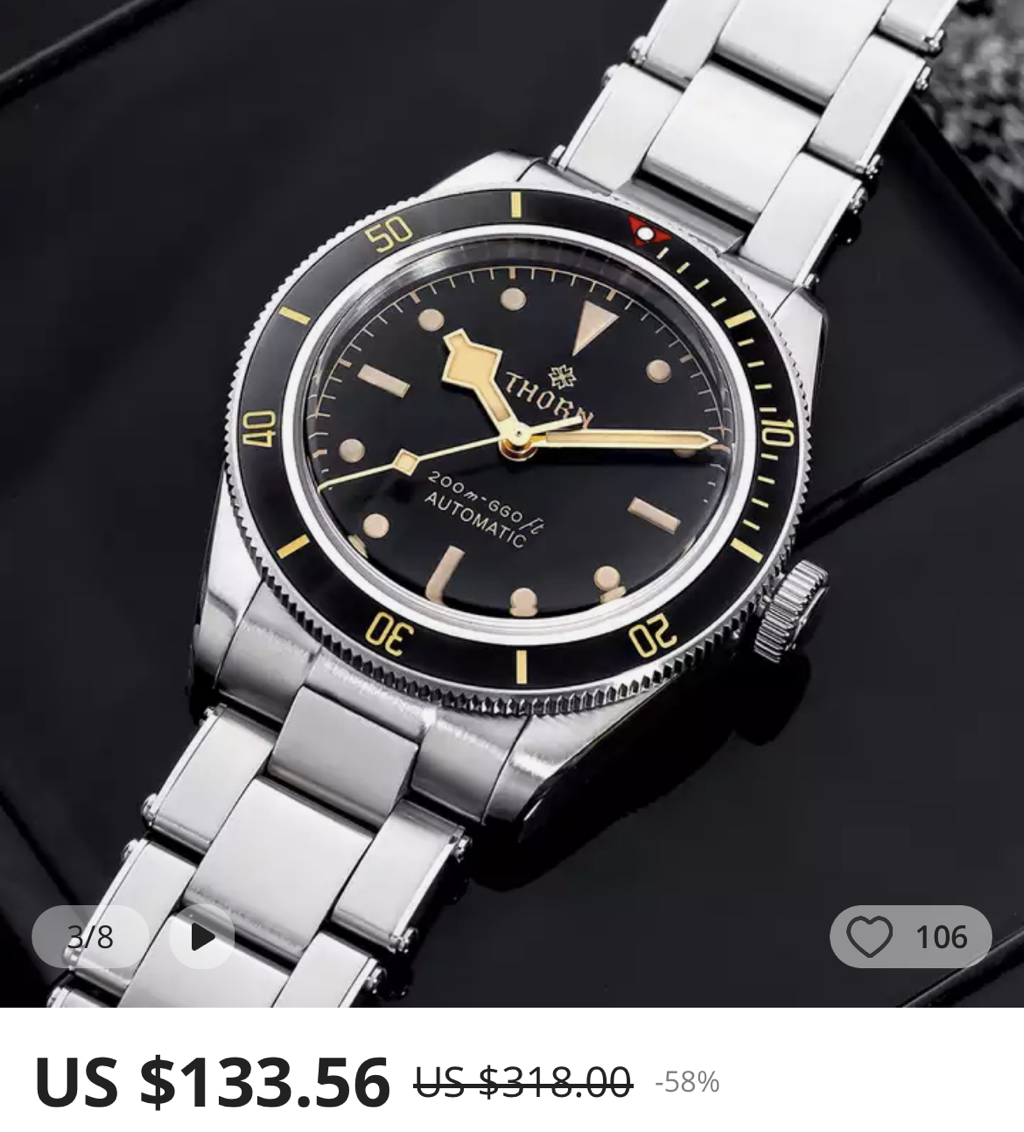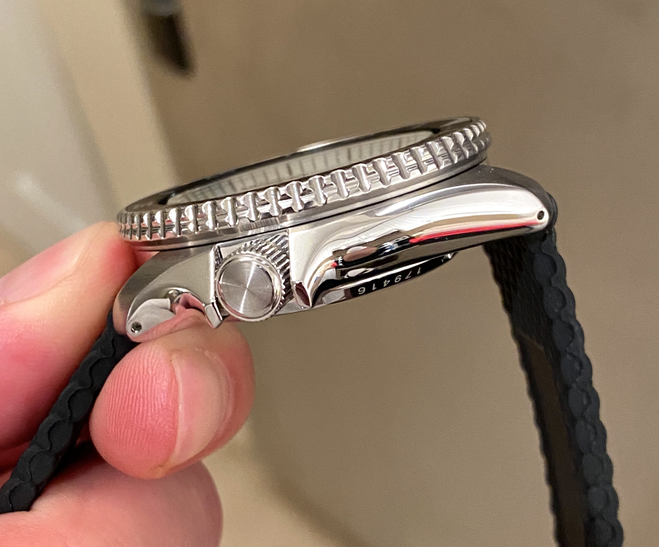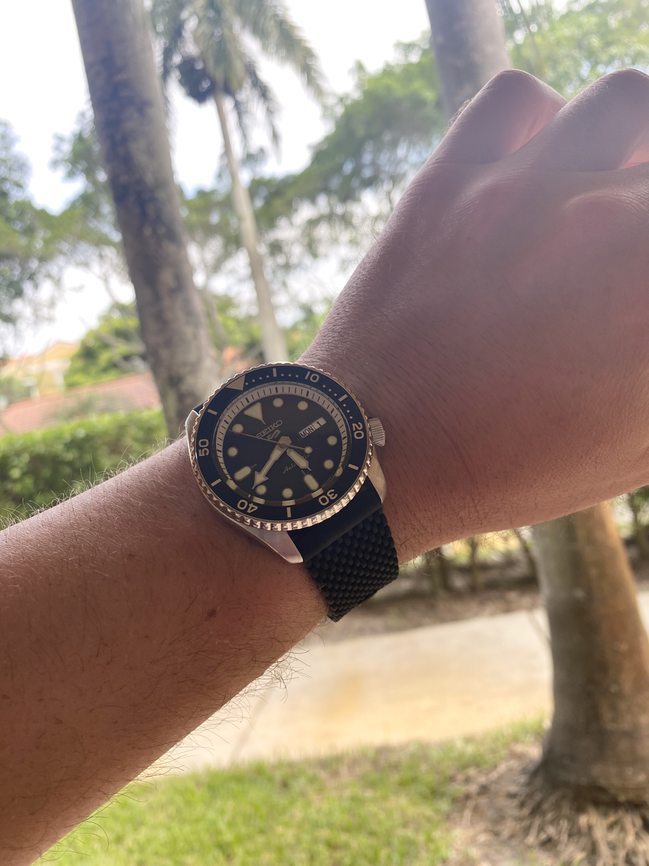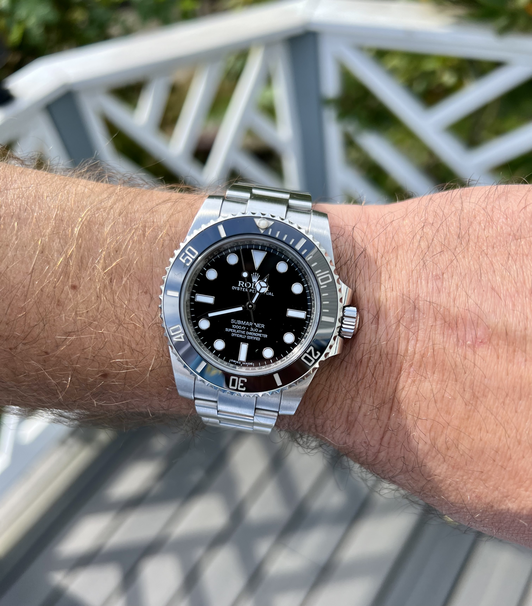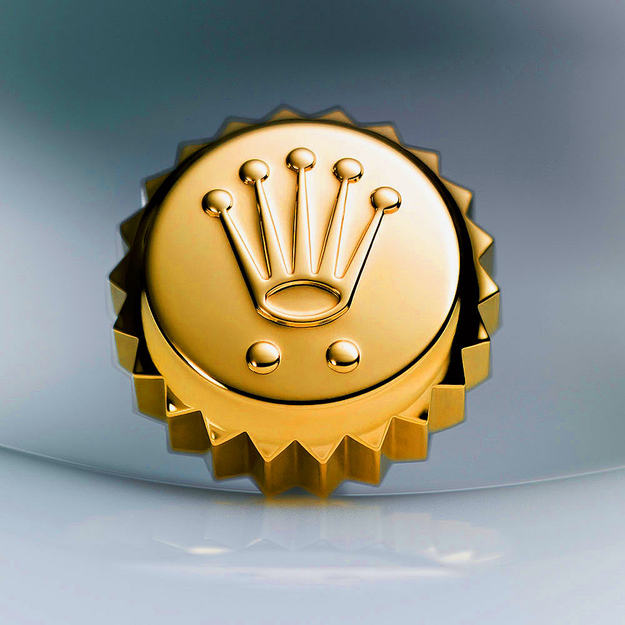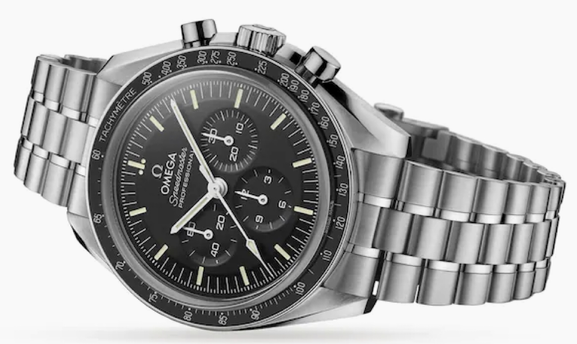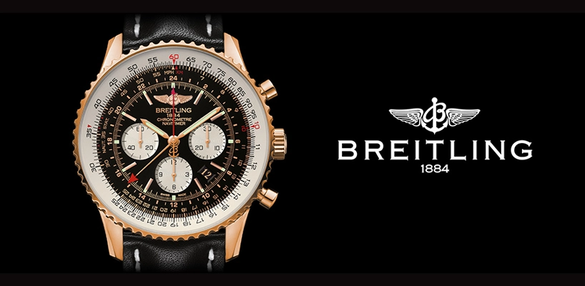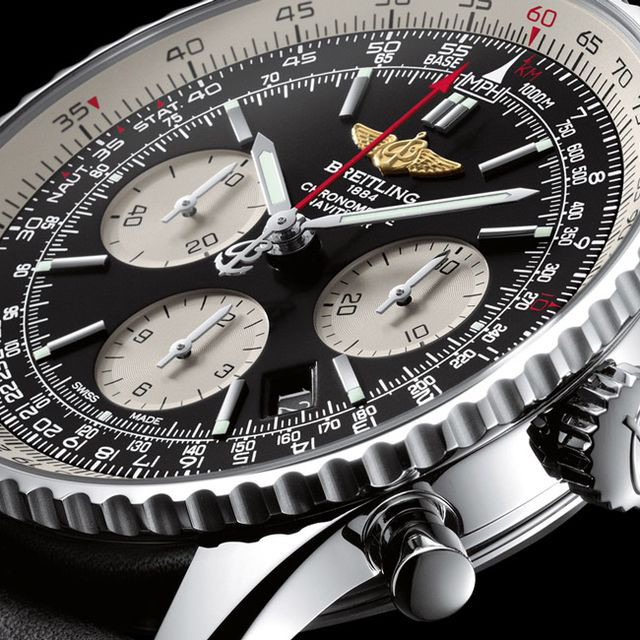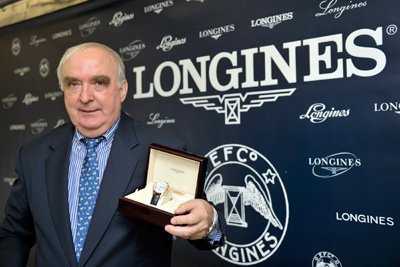|
Case The new "5kx" is here and to no surprise it is a much better and improved watch than the discontinued Seiko SKX series which had a very long and successful run, even though it mad many major flaws and extreme quality control issues. As always in my experience with the Seiko brand, I have honestly never had a quality control issue with a "Seiko 5" model, which I found to be quite odd considering they are cheaper than Prospex and standard models. Anyway, this new Seiko 5 sports has exactly the same case as the SKX minus the drilled lug holes and crown function. The case is comprised of solid 316L stainless steel with brushed lug tops and highly polished sides, as well as the new upgraded exhibition caseback. The measurements come in at 42.5MM x 13.4mm x 46MM with the same 22MM lug width. The finishing is good, for this price and it was also good on the original SKX. I do like the fact that they added drilled lug holes for easy strap changing as this watch is most definitely a strap monster. The crown is actually Pull/Push instead of screwed down and we only get 100M instead of 200M of water resistance. This really is not a big deal considering I can swim with it and I never have gone diving anyway, and probably never will. I do like the exhibition caseback as we do get a glimpse of the custom Seiko rotor, which is a nice little detail for this standard 4R36 caliber. Overall, it really is the perfect size for my 6.75" wrist and wears quite comfortably. Dial The version I chose features a smoky black dial, but it is referred to as black. A nice upgrade is the applied markers with a semi vintage patina look filled with blue seiko lumibrite. The hands remain the same minus the red tipped needle seconds hand, which is a nice little touch by Seiko. This model does feature a white chapter ring which contrasts nicely with the aluminum bezel insert. The bezel action is quite nice and a bit more rigid id say than the SKX. THE BIG THIS IS...that the 120 Click besel actually lines up! There are no alignment issues - atleast on my model! Id say one downgrade is the absence of a lumed 12:00 pip, which is a bit of a letdown - especially at a retail price of $295 USD. The crystal remains the same with seikos own hardlex, which is essentially a hardened mineral crystal. Movement Seiko has upgraded the movement to the 4R36 caliber which has some nice upgrades compared to the previous 7S26 movement. We now get improved accuracy, hacking, manual winding, and a 42 hour power reserve beating away at 3Hz. This movement is extremely rohust and can go years without servicing or error. I think this was the main upgrade many really wanted as so many have modded their standard skxes with NH35 movements. Strap - Silicone band on my model Now, there are numerous dial and case finish / strap iterations of the new Seiko 5 sports models - but I tested my luck and chose the model with the rubber band instead of the standard steel bracelet. And I am quite happy I did! This band is extremely comfortable and even comes fitted with a custom Seiko signed brushed buckle. It kind of resembles a mesh band, which is cool I guess. Anyway, you will not have to change out the band on this one - as it is a good one and definitely a keeper on my watch. ConclusionIm not going to say this is the BEST watch you can get
for under $300.00 but it certainly is a pleaser if you were a previous SKX fan but hated the downsides such as the low end movement, misaligned bezel, and crown issues myself and many others endured. If there was one thing I wish Seiko did, it would be to add a nice sapphire crystal - that would really make my day. I mean it is feasible in other Swiss brands with models priced on the grey market at $300+ such as Hamilton and Tissot models which even feature a swiss automatic movement which certainly costs more to produce and is of higher quality. BUT , if you are a seiko fan and want a tough, waterproof, everyday watch that will last a very long time - Id say go for it / I am definitely enjoying mine a tad more than my previous Seiko SKX007.
0 Comments
|
Archives
February 2024
|
ROLEX HISTORY
Rolex is a Swiss luxury watch brand that was founded in 1905 by Hans Wilsdorf and Alfred Davis in London, England. The company originally began as Wilsdorf and Davis, but it was later renamed to Rolex in 1908.
The first Rolex watches were not manufactured in-house, but instead were made by other watchmakers and then branded with the Rolex name. However, Wilsdorf had a vision of creating a wristwatch that was both reliable and accurate, and he set out to develop his own movements.
In 1910, Rolex became the first wristwatch to receive the Swiss Certificate of Chronometric Precision, which was a testament to the accuracy of the watch. Over the years, Rolex continued to innovate and develop new technologies and features, such as the first waterproof wristwatch in 1926, the first self-winding mechanism in 1931, and the first wristwatch with a date display in 1945.
Rolex has also been associated with several famous individuals, including explorers, athletes, and celebrities. For example, Sir Edmund Hillary and Tenzing Norgay wore Rolex watches when they became the first people to reach the summit of Mount Everest in 1953. Rolex has also been the official timekeeper of several sporting events, including Wimbledon and the Formula 1 Grand Prix.
Today, Rolex is one of the most recognized and respected luxury watch brands in the world, known for its quality, precision, and timeless style.
The first Rolex watches were not manufactured in-house, but instead were made by other watchmakers and then branded with the Rolex name. However, Wilsdorf had a vision of creating a wristwatch that was both reliable and accurate, and he set out to develop his own movements.
In 1910, Rolex became the first wristwatch to receive the Swiss Certificate of Chronometric Precision, which was a testament to the accuracy of the watch. Over the years, Rolex continued to innovate and develop new technologies and features, such as the first waterproof wristwatch in 1926, the first self-winding mechanism in 1931, and the first wristwatch with a date display in 1945.
Rolex has also been associated with several famous individuals, including explorers, athletes, and celebrities. For example, Sir Edmund Hillary and Tenzing Norgay wore Rolex watches when they became the first people to reach the summit of Mount Everest in 1953. Rolex has also been the official timekeeper of several sporting events, including Wimbledon and the Formula 1 Grand Prix.
Today, Rolex is one of the most recognized and respected luxury watch brands in the world, known for its quality, precision, and timeless style.
OMEGA Watches History
Omega is a Swiss luxury watch brand founded in 1848 by Louis Brandt in La Chaux-de-Fonds, Switzerland. The brand initially operated under the name La Generale Watch Co. and produced pocket watches.
In 1894, Omega revolutionized the watch industry with the introduction of the 19-ligne Omega Calibre, which was more accurate and reliable than any other watch movement of the time. This innovation earned Omega numerous awards and accolades, and the brand quickly became known for its precision and quality.
In 1903, Omega was chosen as the official timekeeper for the Gordon Bennett Cup, an international balloon race. This marked the beginning of Omega's long-standing relationship with sports timing and its reputation as a reliable and accurate timekeeper.
In 1932, Omega became the first brand to be awarded the Olympic Cross of Merit for its outstanding contribution to sports timing at the Olympic Games. Since then, Omega has been the official timekeeper for numerous Olympic Games, and its timekeeping technology has continued to evolve and improve.
In the 1950s and 1960s, Omega's watches were worn by famous explorers and adventurers, including Sir Edmund Hillary and Tenzing Norgay during their ascent of Mount Everest in 1953, and Jacques Cousteau during his underwater expeditions.
In the 1960s, Omega introduced the Speedmaster, a chronograph watch that was originally designed for motorsports but became famous as the first watch worn on the moon during the Apollo 11 mission in 1969. The Speedmaster has since become one of Omega's most iconic and sought-after models.
Today, Omega continues to innovate and produce high-quality watches, including the Seamaster, Constellation, and De Ville collections. The brand also continues to be the official timekeeper for numerous sporting events, including the Olympic Games and the America's Cup.
In 1894, Omega revolutionized the watch industry with the introduction of the 19-ligne Omega Calibre, which was more accurate and reliable than any other watch movement of the time. This innovation earned Omega numerous awards and accolades, and the brand quickly became known for its precision and quality.
In 1903, Omega was chosen as the official timekeeper for the Gordon Bennett Cup, an international balloon race. This marked the beginning of Omega's long-standing relationship with sports timing and its reputation as a reliable and accurate timekeeper.
In 1932, Omega became the first brand to be awarded the Olympic Cross of Merit for its outstanding contribution to sports timing at the Olympic Games. Since then, Omega has been the official timekeeper for numerous Olympic Games, and its timekeeping technology has continued to evolve and improve.
In the 1950s and 1960s, Omega's watches were worn by famous explorers and adventurers, including Sir Edmund Hillary and Tenzing Norgay during their ascent of Mount Everest in 1953, and Jacques Cousteau during his underwater expeditions.
In the 1960s, Omega introduced the Speedmaster, a chronograph watch that was originally designed for motorsports but became famous as the first watch worn on the moon during the Apollo 11 mission in 1969. The Speedmaster has since become one of Omega's most iconic and sought-after models.
Today, Omega continues to innovate and produce high-quality watches, including the Seamaster, Constellation, and De Ville collections. The brand also continues to be the official timekeeper for numerous sporting events, including the Olympic Games and the America's Cup.
BREITLING Watches History
Breitling is a Swiss luxury watch brand that was founded in 1884 by Léon Breitling in the town of Saint-Imier in the Canton of Bern, Switzerland. Initially, the company specialized in producing chronographs and other precision timepieces for scientific and industrial purposes.
In 1915, Breitling introduced the first wrist-worn chronograph with a separate pusher to control the start, stop, and reset functions, which made it easier to use than previous models. This innovation helped establish Breitling as a leading maker of chronographs and other precision timepieces.
During the 1930s and 1940s, Breitling continued to innovate with the introduction of the first chronograph with a second independent pusher, which allowed for the recording of multiple elapsed times. The company also developed the Huit Aviation Department, which produced wristwatches for pilots and other aviation professionals.
In the 1950s, Breitling introduced the Navitimer, a wristwatch with a built-in slide rule that allowed pilots to perform complex calculations in-flight. The Navitimer became an instant classic and remains one of Breitling's most popular models to this day.
In the 1960s, Breitling continued to produce innovative timepieces, including the Chrono-Matic, which was the first automatic chronograph movement with a micro-rotor. The company also introduced the Emergency, a wristwatch with a built-in distress beacon that could be activated in case of an emergency.
In the years since, Breitling has continued to produce innovative and high-quality timepieces for a variety of applications, including aviation, diving, and sports. The company has also maintained a strong commitment to precision and accuracy, with many of its watches featuring COSC-certified movements. Today, Breitling is recognized as one of the world's leading luxury watch brands, with a reputation for innovation, quality, and style.
In 1915, Breitling introduced the first wrist-worn chronograph with a separate pusher to control the start, stop, and reset functions, which made it easier to use than previous models. This innovation helped establish Breitling as a leading maker of chronographs and other precision timepieces.
During the 1930s and 1940s, Breitling continued to innovate with the introduction of the first chronograph with a second independent pusher, which allowed for the recording of multiple elapsed times. The company also developed the Huit Aviation Department, which produced wristwatches for pilots and other aviation professionals.
In the 1950s, Breitling introduced the Navitimer, a wristwatch with a built-in slide rule that allowed pilots to perform complex calculations in-flight. The Navitimer became an instant classic and remains one of Breitling's most popular models to this day.
In the 1960s, Breitling continued to produce innovative timepieces, including the Chrono-Matic, which was the first automatic chronograph movement with a micro-rotor. The company also introduced the Emergency, a wristwatch with a built-in distress beacon that could be activated in case of an emergency.
In the years since, Breitling has continued to produce innovative and high-quality timepieces for a variety of applications, including aviation, diving, and sports. The company has also maintained a strong commitment to precision and accuracy, with many of its watches featuring COSC-certified movements. Today, Breitling is recognized as one of the world's leading luxury watch brands, with a reputation for innovation, quality, and style.
Longines
Longines is a Swiss luxury watch company that was founded in 1832 by Auguste Agassiz in the town of Saint-Imier, Switzerland. The company has a long and prestigious history in the world of watchmaking, and has been responsible for many innovations and milestones in the industry.
In the early days, Longines primarily produced pocket watches, and quickly gained a reputation for precision and accuracy. By the end of the 19th century, Longines had become one of the leading watchmakers in the world. In 1912, the company introduced the first chronograph wristwatch, which was quickly adopted by the military and aviation communities.
In the 1920s and 1930s, Longines continued to innovate with the introduction of the world's first quartz clock and the first wristwatch with an automatic winding mechanism. During World War II, Longines produced wristwatches for the British Royal Air Force, and continued to produce military watches for several decades afterwards.
In the post-war years, Longines became known for its elegant and sophisticated watches, particularly its "Conquest" line of watches. In the 1950s and 1960s, Longines was a favorite of celebrities and politicians, and its watches were frequently seen on the wrists of Elvis Presley, John F. Kennedy, and other famous figures.
In recent years, Longines has continued to produce high-quality watches that combine traditional Swiss craftsmanship with modern technology. The company is particularly known for its sport watches, including its "HydroConquest" line of diving watches and its "Conquest Classic" line of chronographs.
Today, Longines is owned by the Swatch Group, and remains a leading brand in the luxury watch industry. Its watches are prized for their precision, reliability, and timeless style.
In the early days, Longines primarily produced pocket watches, and quickly gained a reputation for precision and accuracy. By the end of the 19th century, Longines had become one of the leading watchmakers in the world. In 1912, the company introduced the first chronograph wristwatch, which was quickly adopted by the military and aviation communities.
In the 1920s and 1930s, Longines continued to innovate with the introduction of the world's first quartz clock and the first wristwatch with an automatic winding mechanism. During World War II, Longines produced wristwatches for the British Royal Air Force, and continued to produce military watches for several decades afterwards.
In the post-war years, Longines became known for its elegant and sophisticated watches, particularly its "Conquest" line of watches. In the 1950s and 1960s, Longines was a favorite of celebrities and politicians, and its watches were frequently seen on the wrists of Elvis Presley, John F. Kennedy, and other famous figures.
In recent years, Longines has continued to produce high-quality watches that combine traditional Swiss craftsmanship with modern technology. The company is particularly known for its sport watches, including its "HydroConquest" line of diving watches and its "Conquest Classic" line of chronographs.
Today, Longines is owned by the Swatch Group, and remains a leading brand in the luxury watch industry. Its watches are prized for their precision, reliability, and timeless style.
Tissot
Tissot is a Swiss watch brand that was founded in 1853 by Charles-Félicien Tissot and his son Charles-Émile Tissot in the town of Le Locle, Switzerland. The company has a long and rich history in the world of watchmaking, and has been responsible for many innovations and milestones in the industry.
In the early days, Tissot primarily produced pocket watches, and quickly gained a reputation for quality and precision. By the end of the 19th century, Tissot was one of the largest watchmakers in Switzerland, and was exporting its watches to countries around the world.
In the early 20th century, Tissot continued to innovate with the introduction of the first non-magnetic wristwatch, the first dual time-zone watch, and the first watch with a plastic case. During World War II, Tissot produced watches for the Allied forces, and continued to produce military watches for several decades afterwards.
In the post-war years, Tissot became known for its elegant and sophisticated watches, particularly its "Tissot Visodate" line of watches, which featured a date function and a distinctive "T" logo on the dial. In the 1970s, Tissot was one of the first Swiss watch brands to introduce quartz watches, which quickly became popular due to their accuracy and affordability.
In recent years, Tissot has continued to produce high-quality watches that combine traditional Swiss craftsmanship with modern technology. The company is particularly known for its sport watches, including its "T-Touch" line of watches, which feature touch-screen technology and a range of functions such as altimeter, compass, and thermometer.
Today, Tissot is part of the Swatch Group, and remains a leading brand in the watch industry. Its watches are prized for their quality, durability, and stylish design, and are worn by watch enthusiasts and collectors around the world.
In the early days, Tissot primarily produced pocket watches, and quickly gained a reputation for quality and precision. By the end of the 19th century, Tissot was one of the largest watchmakers in Switzerland, and was exporting its watches to countries around the world.
In the early 20th century, Tissot continued to innovate with the introduction of the first non-magnetic wristwatch, the first dual time-zone watch, and the first watch with a plastic case. During World War II, Tissot produced watches for the Allied forces, and continued to produce military watches for several decades afterwards.
In the post-war years, Tissot became known for its elegant and sophisticated watches, particularly its "Tissot Visodate" line of watches, which featured a date function and a distinctive "T" logo on the dial. In the 1970s, Tissot was one of the first Swiss watch brands to introduce quartz watches, which quickly became popular due to their accuracy and affordability.
In recent years, Tissot has continued to produce high-quality watches that combine traditional Swiss craftsmanship with modern technology. The company is particularly known for its sport watches, including its "T-Touch" line of watches, which feature touch-screen technology and a range of functions such as altimeter, compass, and thermometer.
Today, Tissot is part of the Swatch Group, and remains a leading brand in the watch industry. Its watches are prized for their quality, durability, and stylish design, and are worn by watch enthusiasts and collectors around the world.


